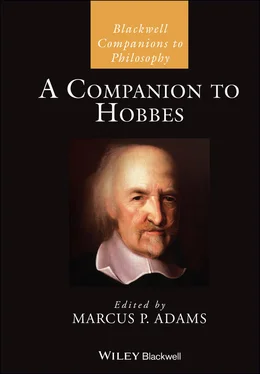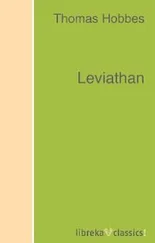For Hobbes, just as our conception of space is derived from the image of body, our notion of time is derived from perceived motion: “a moved body leaves a phantasm of motion, namely an idea of that body passing out of one space and into another by continual succession. And this idea or phantasm … is that which I call TIME” (OL I.83; EW I.94). 10He insists that his own definition of time – “the phantasm of before and after in motion” – is in conformity with Aristotle’s canonical definition – “ the number of motion with respect to before and after ” (OL I.84; EW I.94; see also Anti-White XXVII, 1976, 339–40; Aristotle, Physics , Bk. IV, Ch. 11; 220a25-6; Aristotle 1971, Vol. 1, 373) – since “numbering is an act of the mind” (OL I.84; EW I.95).
But there is another, more radical, sense in which Hobbesian time is imaginary or subjective: “when people speak of the times of their predecessors, they do not think that after their predecessors are gone their times can be anywhere else other than in the memory of those that remember them” (OL I. 84; EW I.94). 11Likewise, in the other temporal direction, “this word future is a name but no future thing has yet any being … nevertheless, since our thought is used to conjoin [ subnectere ] things past with things present the name future serves to signify such conjoining” (EW I.17; OL I.15). Despite this apparent presentism , Hobbes seems to grant mind-independent reality to time. For “ it is inconceivable that anything can be moved without time ” (OL I.97 EW I. 110) 12and he clearly regards motion as mind-independent. Motion, after all, is the real cause of the image of time just as magnitude or “real space” is the cause of imaginary space: “time is the image of motion and has the same relation to real motion as a reflection in a mirror to the true face and a mirrored shape to a true shape” ( Anti-White XXVIII.2; 1976, 339). Furthermore, Hobbes frequently treats the successive duration of motion as mind-independent. Sense, for example, is “some internal motion in the sentient generated by some internal motion of the parts of the object” ( Anti-White XXVIII.2; 1976, 339). Indeed, the internal motions in the brain themselves “remain there for some time” (OL I.320; EW I.393). 13This persistence of sensory motions, which enables memory, is precisely what separates us from mindless objects. So rather than reduce motion and time to the mind, mental processes are themselves explained by motion and time. 14
The Stoics are ambivalent about time for similar reasons. For one thing, it is not a body: “in their view time is one of the incorporeals, which they disparage as inactive and non-existent and subsisting merely in thought” (Proclus, SVF 2.521/LS 51F; 1987, 305). Furthermore, they are presentists. Thus, according to Stobaeus, Chrysippus held “only the present belongs; the past and the future subsist but belong in no way” (Stobaeus, SVF 2.509/LS 51B; 1987, 304; see also Plutarch, SVF LS 51C; 1987, 305). And yet, like Hobbes, they recognize that time is essential to motion: “time is the dimension of motion according to which the measure of speed and slowness is spoken of, or the dimensions accompanying the world’s motion” (Stobaeus, SVF 2.509/LS 51B; 1987, 304; see also Sextus Empiricus, LS 50F; 1987, 299). And there is no indication in Stoic physics that the motion of the universe, or its parts, require imagination. So they classify time, like the void, as an “incorporeal”: something subsisting, which we can speak about and quantify in science and in ordinary life, but lacking independent existence (Sextus Empiricus SVF 2331/LS 27D; 1987, 162). 15
Some scholars have perceived in Hobbes’s philosophy of space and time an anticipation of Kant (Herbert 1977); others (more plausibly) have detected the influence of late scholastic Aristotelianism and nominalism. 16But the guiding principles of Hobbesian metaphysics, materialism, and (what Brandt calls) “motionalism” (Brandt 1917, 379), are what most inform and complicate his treatments of space and time. Without resorting to a “subsistent” incorporeal kind of being, Hobbes nevertheless followed the Stoics in giving time and space a sufficient reality to employ them as independent parameters of mechanistic physics.
For Hobbes, the knowledge of effects from their causes, and vice versa , is the defining feature of philosophy (EW I.3). His own analysis of the causal relation, presented mostly in chapter IX “Of Cause and Effect” in De corpore , is rich and somewhat neglected. 17Here, I will explore one important aspect of this analysis, which is strongly reminiscent of the Stoics’. Together with Spinoza, Hobbes is perhaps the strictest early modern “necessitarian” about the causal connections among bodies. A cause “simply” or “entirely” is a collection of accidents such that “when they are all thought to be present it cannot be understood but that the effect is produced at that same instant. And if any of them be wanting it cannot be supposed but that the effect is not produced” (EW I.122). Men call things “contingent, whereof they do not perceive the necessary cause” (EW I.130). Hobbes argues the conceptual inter-dependence of simple causes and their effects is crucial for several principles at the foundation of his physics, including “no action at a distance” (EW I.125), “same cause/same effect” (EW I.125-6), and the inertia of both motion and rest (EW I.125).
The Stoics are committed to very similar causal principles. Alexander attributes to the Stoics that “from everything that happens, something else follows, with a necessary causal dependence on it, and everything that happens has something prior to it with which it causally coheres” (LS 1987, 337; see also LS 1987, 333; 389–90). Like Hobbes, the Stoics emphasize that the necessary connection applies to what they call “complete” or “sustaining” causes, i.e., “one during whose presence the effect remains and on whose removal the effect is effect is removed” (LS 1987, 336). As Hobbes later does, they derive from this conception of complete causality the principle that “where all the same circumstances obtain it is impossible that a result that does not ensue on one occasion should ensue on another” (LS 1987, 338). We call things “accidental” or “spontaneous” only because “there are causes hidden from our sight” (Plutarch, On Stoic Self Contradictions ; In Sambursky 2014, 56). And they hold that all causal connections are by direct contact or through the medium of pneuma (Sambursky 2014, 54). As Hobbes later would, albeit from a more sophisticated and quantitative perspective, the Stoics perceived their necessitarian causal principles as required by their overall materialist cosmology: “the world would be wrenched apart and divided and no longer form a unity, forever governed by a single ordering and management, if an uncaused motion were introduced” (LS 1987, 337–8; see also Sambursky 2014, 130). 18
Since Hobbes was avowedly both a theist and a materialist, his God must be some sort of body. As noted above, he says so much in a brief dialogue appended to the Latin edition of Leviathan (1668), where Hobbes’s mouthpiece “B” brashly “affirms, of course, that God is body.” 19Concurrently, his longtime intellectual frenemy, Anglican Bishop John Bramhall, pressed Hobbes on the same question: since Hobbes considers “incorporeal substance” contradictory, Bramhall asks, what then does he “leave God himself to be?” (1842–1844, IV.525). Hobbes pulls no punches: “I leave him to be a most pure, simple, invisible spirit corporeal” (EW IV.313). 20In recent scholarship, this late confession of corporeal theism has generally been dismissed as either atheistic dissimulation or a clumsy statement of sincere of Calvinist minimalism. 21This is understandable. After all, taken on its face, where could Hobbes have obtained such an idea? 22The answer is: from classical Stoicism.
Читать дальше












